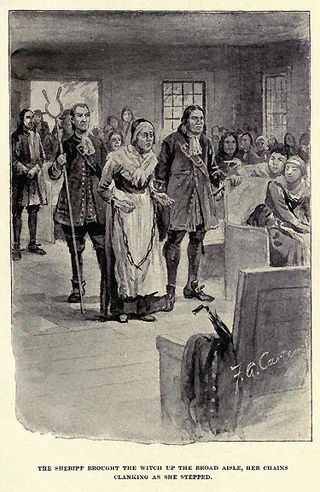
The Salem witch trials were a series of hearings and prosecutions of people accused of witchcraft in colonial Massachusetts between February 1692 and May 1693. More than 200 people were accused. Thirty people were found guilty, nineteen of whom were executed by hanging. One other man, Giles Corey, died under torture after refusing to enter a plea, and at least five people died in jail.

Tituba was a Native American enslaved woman who was one of the first to be accused of witchcraft during the Salem witch trials of 1692–1693.

Bridget Bishop was the first person executed for witchcraft during the Salem witch trials in 1692. Nineteen were hanged, and one, Giles Corey, was pressed to death. Altogether, about 200 people were tried.

Sarah Good was one of the first three women to be accused of witchcraft in the Salem witch trials, which occurred in 1692 in colonial Massachusetts.

Partus sequitur ventrem was a legal doctrine passed in colonial Virginia in 1662 and other English crown colonies in the Americas which defined the legal status of children born there; the doctrine mandated that children of slave mothers would inherit the legal status of their mothers. As such, children of enslaved women would be born into slavery. The legal doctrine of partus sequitur ventrem was derived from Roman civil law, specifically the portions concerning slavery and personal property (chattels), as well as the common law of personal property.

Eunice Cole, maiden name unknown, was a woman from the coast of New Hampshire. Better known as "Goody Cole", she is the only woman convicted of witchcraft in New Hampshire.

Susannah Martin was one of fourteen women executed for the suspicion of practicing witchcraft during the Salem witch trials of colonial Massachusetts.

Rebecca Nurse was a woman who was accused of witchcraft and executed by hanging in New England during the Salem Witch Trials of 1692. She was fully exonerated fewer than twenty years later.
Dorothy Good was the daughter of William Good and Sarah Good.
Emma Augusta Hempstead Cunningham (1818–1887) was a young woman from New York City who was embroiled in a scandalous relationship that ended in a crime of murder. She was arrested for murder and fraud, and was sent to trial in one of the most famous cases in the Victorian-era.
The Roermond witch trial, which took place in and around the city of Roermond in the Spanish Netherlands in 1613, was the largest witch trial in present-day The Netherlands. It caused the death of sixty four people by burning.

Elizabeth Key Grinstead (or Greenstead) (1630 – January 20, 1665) was one of the first black people of the Thirteen Colonies to sue for freedom from slavery and win. Key won her freedom and that of her infant son John Grinstead on July 21, 1656, in the colony of Virginia.
Margaret Jones was the first person to be executed for witchcraft in Massachusetts Bay Colony, and the second in New England during a witch-hunt that lasted from 1647 to 1693. Hundreds of people throughout New England were accused of practicing witchcraft during that period, including over two hundred in 1692 during the Salem Witch Trials. Prior to the Salem Witch Trials of 1692, over a forty-one year period (1647–1688), nine women, including Margaret Jones, were hanged as witches.

Freedom suits were lawsuits in the Thirteen Colonies and the United States filed by slaves against slaveholders to assert claims to freedom, often based on descent from a free maternal ancestor, or time held as a resident in a free state or territory.
Grace White Sherwood (1660–1740), called the Witch of Pungo, is the last person known to have been convicted of witchcraft in Virginia.
The witch trials in Connecticut, also sometimes referred to as the Hartford witch trials, occurred from 1647 to 1663. They were the first large-scale witch trials in the American colonies, predating the Salem Witch Trials by nearly thirty years. John M. Taylor lists a total of 37 cases, 11 of which resulted in executions. The execution of Alse Young of Windsor in the spring of 1647 was the beginning of the witch panic in the area, which would not come to an end until 1670 with the release of Katherine Harrison.

The Maryland Witch Trials were a series of hearings and prosecutions of people accused of witchcraft in Colonial Maryland between June 1654, and October 1712. It was not unique, but is a Colonial American example of the much broader phenomenon of witch trials in the early modern period, which took place also in Europe.
Rebecca Fowler was a woman convicted and executed for witchcraft in 17th-century Maryland. Around a dozen witch trials were conducted in Maryland during the 17th and 18th centuries, with most being acquitted. Fowler is the only documented legal execution of an alleged witch in Maryland history.

During a 104-year period from 1626 to 1730, there are documented Virginia Witch Trials, hearings and prosecutions of people accused of witchcraft in Colonial Virginia. More than two dozen people are documented having been accused, including two men. Virginia was the first colony to have a formal accusation of witchcraft in 1626, and the first formal witch trial in 1641.
The views of witchcraft in North America have evolved through an interlinking history of cultural beliefs and interactions. These forces contribute to complex and evolving views of witchcraft. Today, North America hosts a diverse array of beliefs about witchcraft.